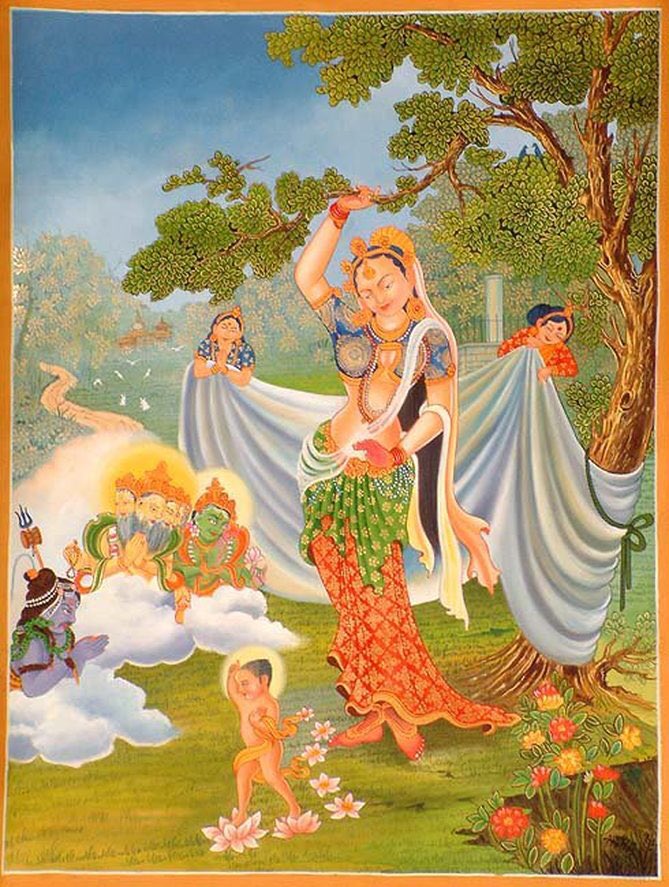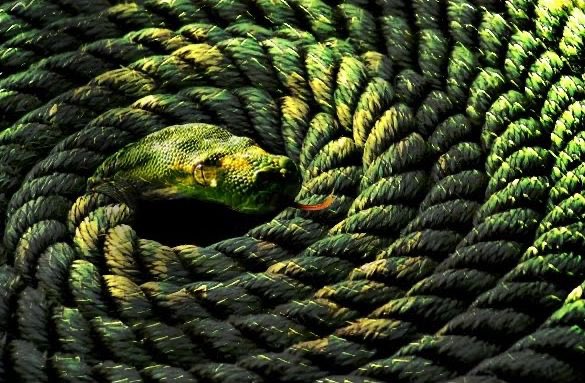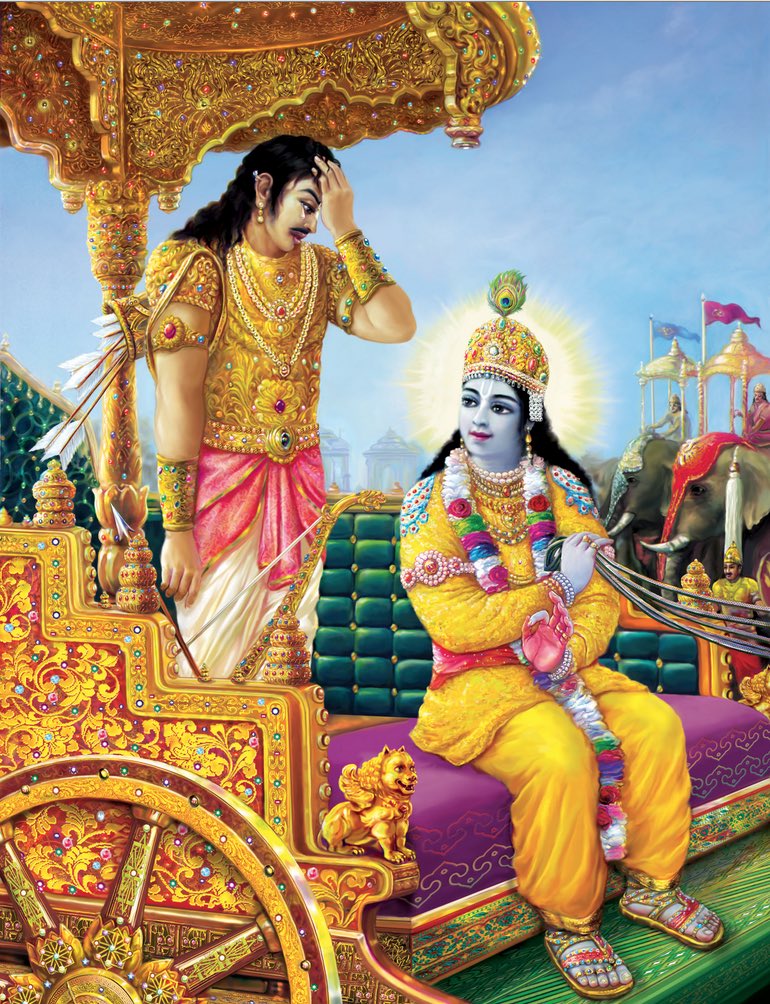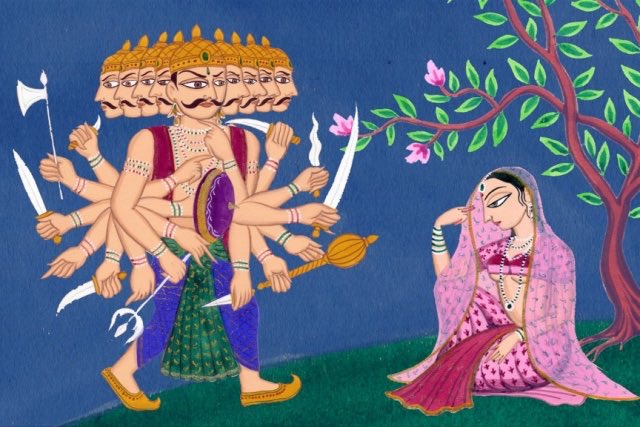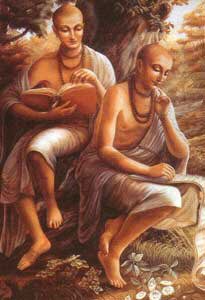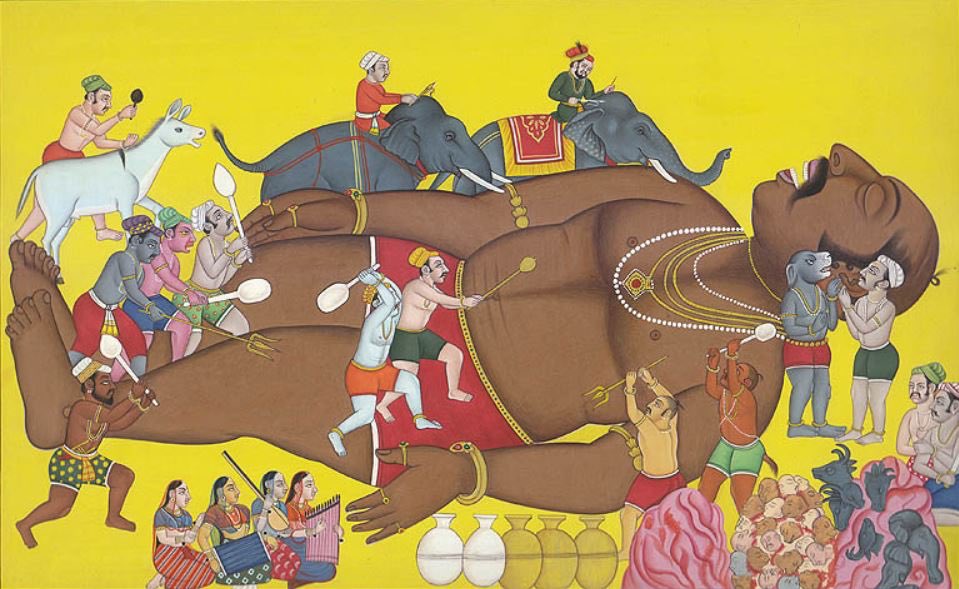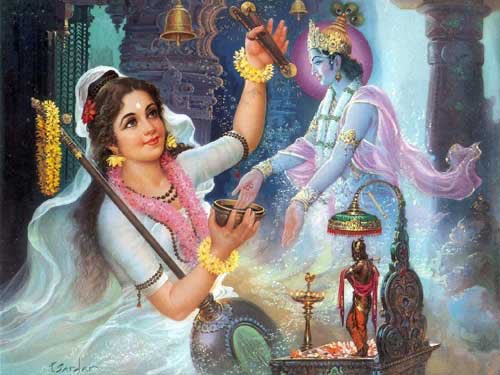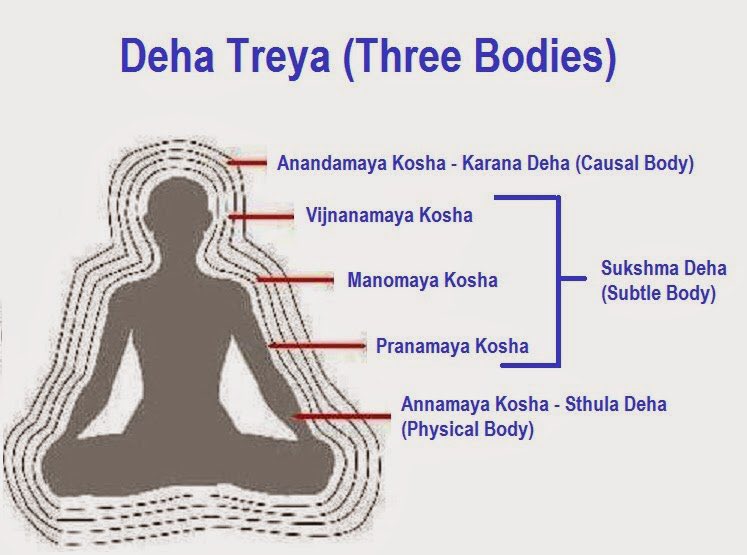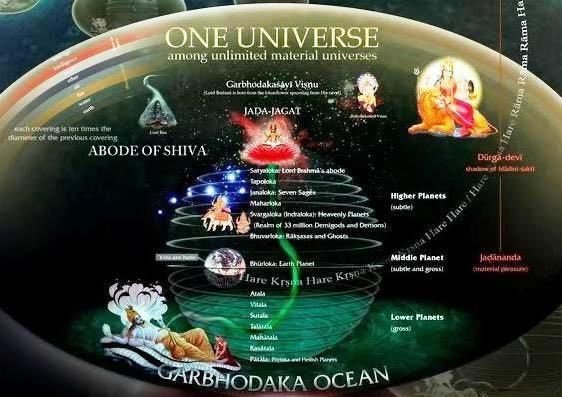What is Māyā? Part 3: A thread
Vivekacūdāmaṇi, Verses 110-123
शुद्धाद्वयब्रह्मविभोधनाश्या
सर्पभ्रमो रज्जुविवेकतो यथा ।
रजस्तमःसत्त्वमिति प्रसिद्धा
गुणास्तदीयाः प्रथितैः स्वकार्यैः ॥ (110)
Vivekacūdāmaṇi, Verses 110-123
शुद्धाद्वयब्रह्मविभोधनाश्या
सर्पभ्रमो रज्जुविवेकतो यथा ।
रजस्तमःसत्त्वमिति प्रसिद्धा
गुणास्तदीयाः प्रथितैः स्वकार्यैः ॥ (110)
Māyā can be destroyed by the realisation of the pure Brahman, the one without a second, just as the mistaken idea of a snake is removed by the discrimination of the rope. She has her Guṇas as Rajas, Tamas and Sattva, named after their respective functions.
विक्षेपशक्ती रजसः क्रियात्मिका
यतः प्रवृत्तिः प्रसृता पुराणी ।
रागादयोऽस्याः प्रभवन्ति नित्यं
दुःखादयो ये मनसो विकाराः ॥ (111)
यतः प्रवृत्तिः प्रसृता पुराणी ।
रागादयोऽस्याः प्रभवन्ति नित्यं
दुःखादयो ये मनसो विकाराः ॥ (111)
Rajas has its Vikṣepa-Śakti (projecting power), which is of the nature of an activity, and from which this primeval flow of activity has emanated. From this also, mental modifications such as attachment and grief are continually produced.
कामः क्रोधो लोभदम्भाद्यसूया
अहंकारेर्ष्यामत्सराद्यास्तु घोराः ।
धर्मा एते राजसाः पुम्प्रवृत्तिः
यस्मादेषा तद्रजो बन्धहेतुः ॥ (112)
अहंकारेर्ष्यामत्सराद्यास्तु घोराः ।
धर्मा एते राजसाः पुम्प्रवृत्तिः
यस्मादेषा तद्रजो बन्धहेतुः ॥ (112)
Lust, anger, extreme greed, arrogance, malice, egoism, envy, jealousy, etc., - these are the harmful attributes of Rajas, from which the worldly tendency of ‘being human’ is produced. Therefore Rajas is a cause of bondage.
एषावृतिर्नाम तमोगुणस्य
शक्तिर्मया वस्त्ववभासतेऽन्यथा ।
सैषा निदानं पुरुषस्य संसृतेः
विक्षेपशक्तेः प्रवणस्य हेतुः ॥ (113)
शक्तिर्मया वस्त्ववभासतेऽन्यथा ।
सैषा निदानं पुरुषस्य संसृतेः
विक्षेपशक्तेः प्रवणस्य हेतुः ॥ (113)
Āvṛti (Veiling Power) is the power of Tamas, which makes things appear other than what they truly are. It is this that causes one’s repeated transmigrations in the cycle of rebirth, and starts the action of the projecting power (Vikṣepa).
प्रज्ञावानपि पण्डितोऽपि चतुरोऽप्यत्यन्तसूक्ष्मात्मदृग्
व्यालीढस्तमसा न वेत्ति बहुधा संबोधितोऽपि स्फुटम् ।
भ्रान्त्यारोपितमेव साधु कलयत्यालम्बते तद्गुणान्
हन्तासौ प्रबला दुरन्ततमसः शक्तिर्महत्यावृतिः ॥ (114)
व्यालीढस्तमसा न वेत्ति बहुधा संबोधितोऽपि स्फुटम् ।
भ्रान्त्यारोपितमेव साधु कलयत्यालम्बते तद्गुणान्
हन्तासौ प्रबला दुरन्ततमसः शक्तिर्महत्यावृतिः ॥ (114)
Even the wise and learned scholars and those who are capable of gaining a vision of the very subtle Ātman, are overpowered by Tamas and cannot understand it, despite being clearly explained in various ways.
What is simply superimposed by delusion, they consider as true, and attach themselves to its effects. Alas! How powerful is the great Āvṛti Shakti of dreadful Tamas!
अभावना वा विपरीतभावना
असंभावना विप्रतिपत्तिरस्याः ।
संसर्गयुक्तं न विमुञ्चति ध्रुवं
विक्षेपशक्तिः क्षपयत्यजस्रम् ॥ (115)
असंभावना विप्रतिपत्तिरस्याः ।
संसर्गयुक्तं न विमुञ्चति ध्रुवं
विक्षेपशक्तिः क्षपयत्यजस्रम् ॥ (115)
Absence of the right judgment, or contrary judgment, insistence in belief of something one is uncertain of, and doubt – these certainly never leave one who has any connection with this veiling power, due to which the projecting power gives endless trouble.
अज्ञानमालस्यजडत्वनिद्रा
प्रमादमूढत्वमुखास्तमोगुणाः ।
एतैः प्रयुक्तो नहि वेत्ति किंचिन्
निद्रालुवत्स्तम्भवदेव तिष्ठति ॥ (116)
प्रमादमूढत्वमुखास्तमोगुणाः ।
एतैः प्रयुक्तो नहि वेत्ति किंचिन्
निद्रालुवत्स्तम्भवदेव तिष्ठति ॥ (116)
Ignorance, laziness, dullness, sleep, inertia, stupidity, etc., are attributes of Tamas. One tied to these does not comprehend anything, but remains like one asleep or like a pillar.
सत्त्वं विशुद्धं जलवत्तथापि
ताभ्यां मिलित्वा सरणाय कल्पते ।
यत्रात्मबिम्बः प्रतिबिम्बितः सन्
प्रकाशयत्यर्क इवाखिलं जडम् ॥ (117)
ताभ्यां मिलित्वा सरणाय कल्पते ।
यत्रात्मबिम्बः प्रतिबिम्बितः सन्
प्रकाशयत्यर्क इवाखिलं जडम् ॥ (117)
Pure Sattva is (clear) like water, yet in conjunction with Rajas and Tamas it allows for transmigration (rebirth) to occur. The reality of the Ātman becomes reflected in Sattva and like the sun reveals the entire world of matter.
मिश्रस्य सत्त्वस्य भवन्ति धर्माः
त्वमानिताद्या नियमा यमाद्याः ।
श्रद्धा च भक्तिश्च मुमुक्षता च
दैवी च सम्पत्तिरसन्निवृत्तिः ॥ (118)
त्वमानिताद्या नियमा यमाद्याः ।
श्रद्धा च भक्तिश्च मुमुक्षता च
दैवी च सम्पत्तिरसन्निवृत्तिः ॥ (118)
The traits of a mixed Sattva are an utter absence of pride etc., and Niyama (duties), Yama (discipline), etc., as well as faith, devotion, yearning for Liberation, the divine tendencies and turning away from the unreal.
विशुद्धसत्त्वस्य गुणाः प्रसादः
स्वात्मानुभूतिः परमा प्रशान्तिः ।
तृप्तिः प्रहर्षः परमात्मनिष्ठा
यया सदानन्दरसं समृच्छति ॥ (119)
स्वात्मानुभूतिः परमा प्रशान्तिः ।
तृप्तिः प्रहर्षः परमात्मनिष्ठा
यया सदानन्दरसं समृच्छति ॥ (119)
The traits of pure Sattva (unmixed with Rajas and Tamas) are cheerfulness, the realisation of one’s own Self, supreme peace, contentment, bliss, and steady devotion to the Ātman, by which the aspirant enjoys bliss everlasting.
अव्यक्तमेतत्त्रिगुणैर्निरुक्तं
तत्कारणं नाम शरीरमात्मनः ।
सुषुप्तिरेतस्य विभक्त्यवस्था
प्रलीनसर्वेन्द्रियबुद्धिवृत्तिः ॥ (120)
तत्कारणं नाम शरीरमात्मनः ।
सुषुप्तिरेतस्य विभक्त्यवस्था
प्रलीनसर्वेन्द्रियबुद्धिवृत्तिः ॥ (120)
This Unmanifest Māyā, spoken of as the compound of the three Guṇas, is the causal body (Kāraṇa Śarīra) of the Self. Deep sleep is its special state, in which the functions of the mind and all its organs are at rest, in ignorance.
सर्वप्रकारप्रमितिप्रशान्तिः
बीजात्मनावस्थितिरेव बुद्धेः ।
सुषुप्तिरेतस्य किल प्रतीतिः
किंचिन्न वेद्मीति जगत्प्रसिद्धेः ॥ (121)
बीजात्मनावस्थितिरेव बुद्धेः ।
सुषुप्तिरेतस्य किल प्रतीतिः
किंचिन्न वेद्मीति जगत्प्रसिद्धेः ॥ (121)
Deep sleep is the end of all kinds of perception (including remembrance and delusion), in which the mind remains in a subtle seed-like form. The test of this is the universal verdict, "I did not know anything then". This negative memory proves the continuity of the mind in sleep
देहेन्द्रियप्राणमनोऽहमादयः
सर्वे विकारा विषयाः सुखादयः ।
व्योमादिभूतान्यखिलं न विश्वं
अव्यक्तपर्यन्तमिदं ह्यनात्मा ॥ (122)
सर्वे विकारा विषयाः सुखादयः ।
व्योमादिभूतान्यखिलं न विश्वं
अव्यक्तपर्यन्तमिदं ह्यनात्मा ॥ (122)
The body, organs, Prāṇas (vital airs), Manas (Mind), egoism, etc., all modifications, the sense-objects, pleasure and the rest, the gross elements such as the ether, in fact, the whole universe, up to the Unmanifest – all this is the non-Self.
माया मायाकार्यं सर्वं महदादिदेहपर्यन्तम् ।
असदिदमनात्मतत्त्वं विद्धि त्वं मरुमरीचिकाकल्पम् ॥ (123)
असदिदमनात्मतत्त्वं विद्धि त्वं मरुमरीचिकाकल्पम् ॥ (123)

 Read on Twitter
Read on Twitter